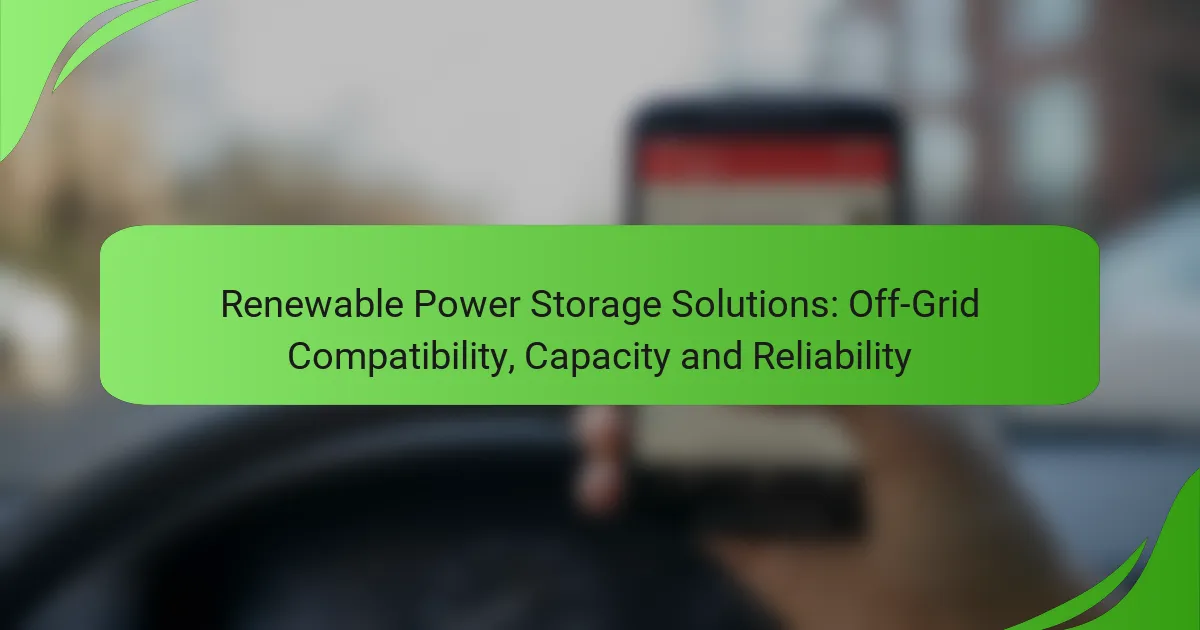Renewable power storage solutions are essential for off-grid systems, offering various options such as lithium-ion batteries, lead-acid batteries, and hydrogen storage systems. Each type presents distinct characteristics that affect their capacity, reliability, and performance in isolated energy environments. By leveraging advanced technologies and maintenance practices, these systems ensure a stable and consistent energy supply, tailored to meet specific usage patterns and environmental conditions.
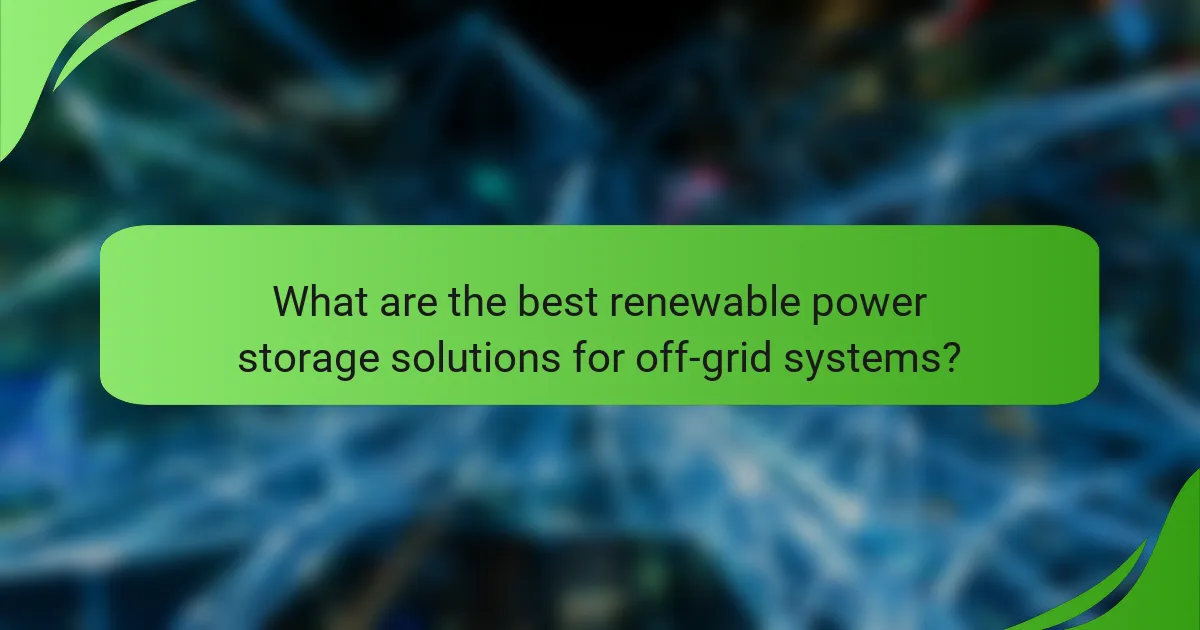
What are the best renewable power storage solutions for off-grid systems?
The best renewable power storage solutions for off-grid systems include lithium-ion batteries, lead-acid batteries, flow batteries, hydrogen storage systems, and supercapacitors. Each option has unique characteristics that influence capacity, reliability, and overall performance in off-grid applications.
Lithium-ion batteries
Lithium-ion batteries are popular for off-grid systems due to their high energy density and efficiency. They typically offer a lifespan of 10-15 years and can handle deep discharges without significant degradation.
When selecting lithium-ion batteries, consider factors such as capacity (measured in kilowatt-hours, kWh), charge cycles, and temperature tolerance. They are generally more expensive upfront but provide better long-term value due to lower maintenance costs.
Lead-acid batteries
Lead-acid batteries are a traditional choice for off-grid systems, known for their reliability and lower initial costs. They come in two main types: flooded and sealed (AGM or gel), with flooded batteries requiring regular maintenance.
These batteries typically have a shorter lifespan of 3-5 years and are less efficient than lithium-ion options. However, they can be a cost-effective solution for users with lower energy needs or those on a tighter budget.
Flow batteries
Flow batteries are an emerging technology that offers scalability and long-duration energy storage. They work by circulating electrolyte solutions through a cell stack, allowing for flexible sizing based on energy needs.
While flow batteries have a longer lifespan and can be cycled many times without degradation, they are currently less common and can be more expensive than traditional options. They are ideal for applications requiring large amounts of energy over extended periods.
Hydrogen storage systems
Hydrogen storage systems convert excess renewable energy into hydrogen through electrolysis, which can later be converted back into electricity using fuel cells. This method allows for long-term energy storage and transportability.
While hydrogen systems can be efficient, they require significant infrastructure and investment. They are best suited for larger off-grid applications or hybrid systems that integrate multiple energy sources.
Supercapacitors
Supercapacitors store energy electrostatically and can deliver rapid bursts of power, making them suitable for applications requiring quick charge and discharge cycles. They have a very long cycle life but lower energy density compared to batteries.
These devices are often used in conjunction with batteries to enhance performance, especially in systems where quick response times are critical. However, their higher cost per kWh can be a limiting factor for standalone use in off-grid systems.
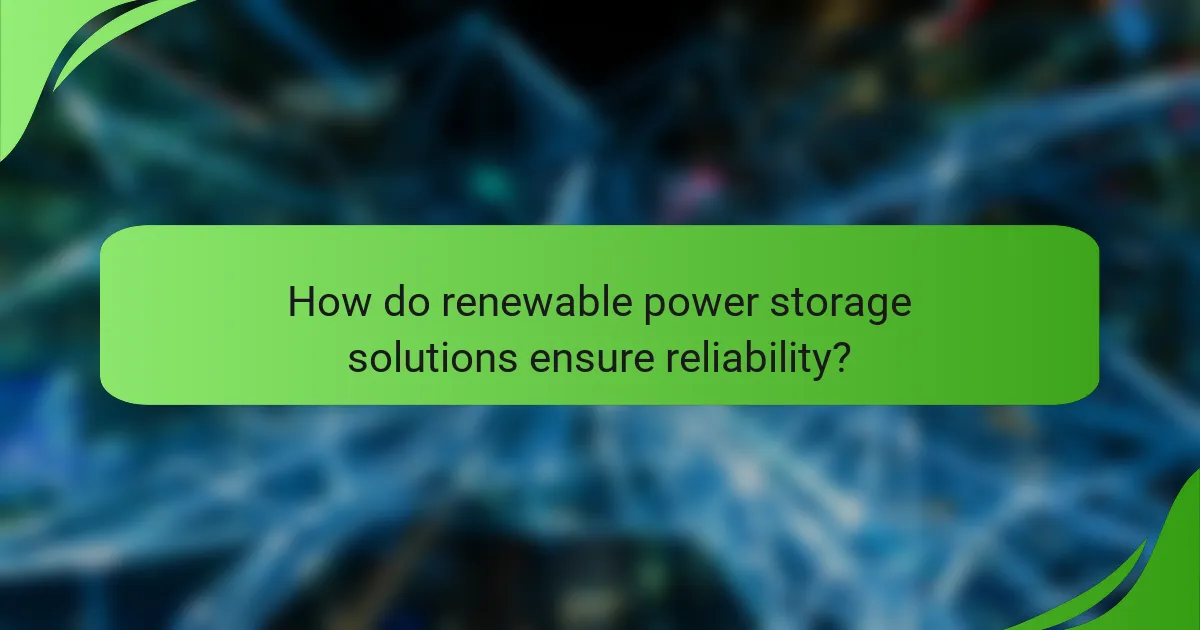
How do renewable power storage solutions ensure reliability?
Renewable power storage solutions ensure reliability by integrating advanced technologies and practices that maintain consistent energy availability. Key components include battery management systems, redundancy in storage, and regular maintenance practices, all of which contribute to the overall stability of energy supply.
Battery management systems
Battery management systems (BMS) are crucial for monitoring and controlling battery performance, ensuring optimal operation and longevity. They track parameters such as voltage, temperature, and state of charge, preventing overcharging and deep discharging, which can damage batteries. A well-functioning BMS can enhance the reliability of energy storage by extending battery life and improving efficiency.
When selecting a BMS, consider features like real-time monitoring and communication capabilities. These systems can provide alerts for maintenance needs or performance issues, allowing for timely interventions that enhance reliability.
Redundancy in storage
Redundancy in storage involves having multiple energy storage units or systems in place to ensure continuous power supply, even if one component fails. This can be achieved through parallel battery systems or hybrid setups that combine different storage technologies, such as lithium-ion batteries and flow batteries. Redundant systems can significantly reduce the risk of outages and improve overall reliability.
For off-grid applications, consider implementing a redundancy strategy that includes at least two different types of storage solutions. This approach not only enhances reliability but also allows for flexibility in energy management, adapting to varying energy demands.
Regular maintenance practices
Regular maintenance practices are essential for ensuring the reliability of renewable power storage systems. Scheduled inspections and servicing can identify potential issues before they escalate, maintaining optimal performance. Common maintenance tasks include checking battery connections, cleaning terminals, and verifying the functionality of the BMS.
Establish a maintenance schedule based on manufacturer recommendations and system usage. Keeping detailed records of maintenance activities can help track performance trends and inform future upgrades or replacements, ultimately enhancing the reliability of the energy storage solution.
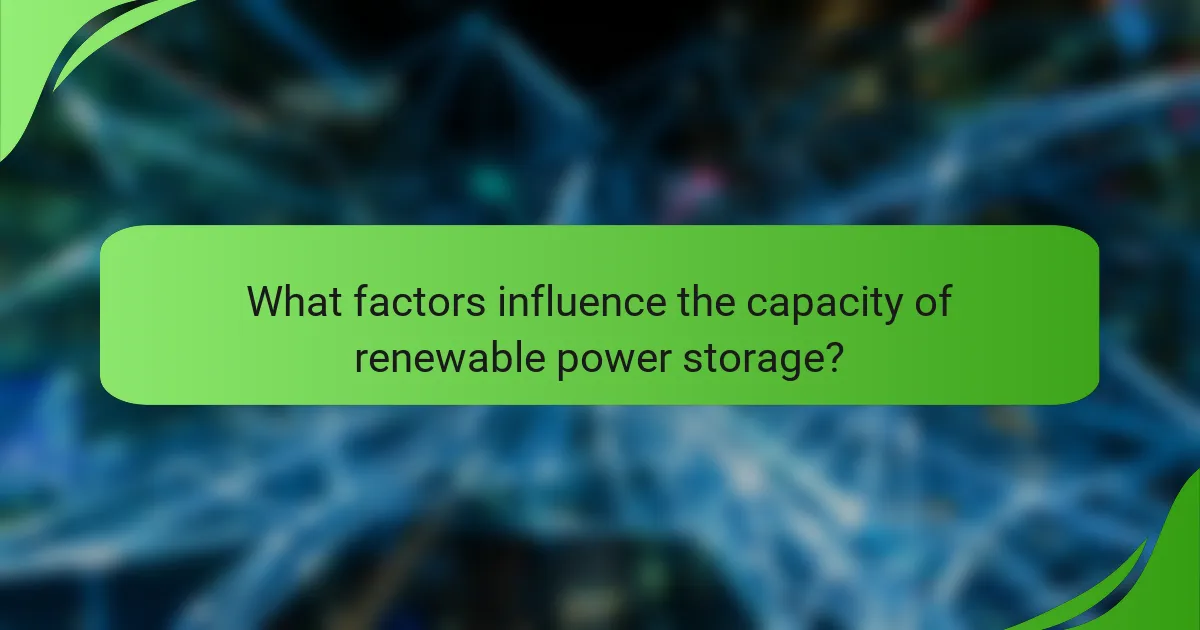
What factors influence the capacity of renewable power storage?
The capacity of renewable power storage systems is influenced by several key factors, including battery chemistry, temperature effects, and usage patterns. Understanding these elements helps in optimizing storage solutions for off-grid applications.
Battery chemistry
Battery chemistry plays a crucial role in determining the capacity and efficiency of renewable power storage. Different chemistries, such as lithium-ion, lead-acid, and flow batteries, have varying energy densities, charge cycles, and lifespans. For instance, lithium-ion batteries typically offer higher energy density and longer life compared to lead-acid batteries, making them a popular choice for off-grid systems.
When selecting a battery type, consider factors like cost, availability, and environmental impact. Lithium-ion batteries may have a higher upfront cost but can provide better performance and longevity, which may offset initial expenses over time.
Temperature effects
Temperature significantly affects the performance and capacity of renewable power storage systems. Most batteries operate optimally within a specific temperature range, generally between 20°C and 25°C. Extreme temperatures can lead to reduced efficiency, shorter lifespan, and even safety hazards.
To mitigate temperature-related issues, consider installing batteries in climate-controlled environments or using thermal management systems. This can help maintain optimal operating conditions, ensuring reliable performance and maximizing capacity.
Usage patterns
Usage patterns directly impact the capacity and effectiveness of renewable power storage. Understanding how and when energy is consumed can help in designing a storage system that meets specific needs. For example, if energy demand peaks during the day, a system that charges during sunlight hours and discharges in the evening may be ideal.
Monitoring energy consumption patterns can also reveal opportunities for efficiency improvements. Implementing energy-saving practices or adjusting usage times can enhance the overall effectiveness of the storage solution, ensuring that it meets both current and future energy needs.

How to choose the right renewable power storage solution?
Selecting the right renewable power storage solution involves understanding your energy requirements, available space, and budget constraints. A well-chosen system enhances efficiency and reliability for off-grid applications.
Assess energy needs
Begin by determining your daily energy consumption. Consider the total wattage of all devices you plan to power and how many hours they will run each day. This will help you identify the capacity required from your storage solution.
For example, if your household uses around 30 kWh per day, you may need a battery system with a capacity of at least 10-15 kWh to ensure reliable performance, accounting for inefficiencies and potential energy shortages.
Evaluate space constraints
Space availability is crucial when selecting a renewable power storage system. Assess the area where you plan to install the batteries, considering both the footprint and the height of the units. Some batteries require more ventilation or specific mounting conditions.
For instance, lithium-ion batteries are often more compact than lead-acid options, making them suitable for smaller spaces. Ensure there is adequate room for maintenance and potential expansion in the future.
Consider budget and ROI
Your budget will significantly influence the type of renewable power storage solution you choose. Prices can vary widely, with basic systems starting in the low thousands of USD and advanced setups reaching tens of thousands.
Evaluate the return on investment (ROI) by considering factors such as energy savings, potential rebates, and the lifespan of the system. A higher upfront cost may be justified if the system offers substantial long-term savings and reliability.
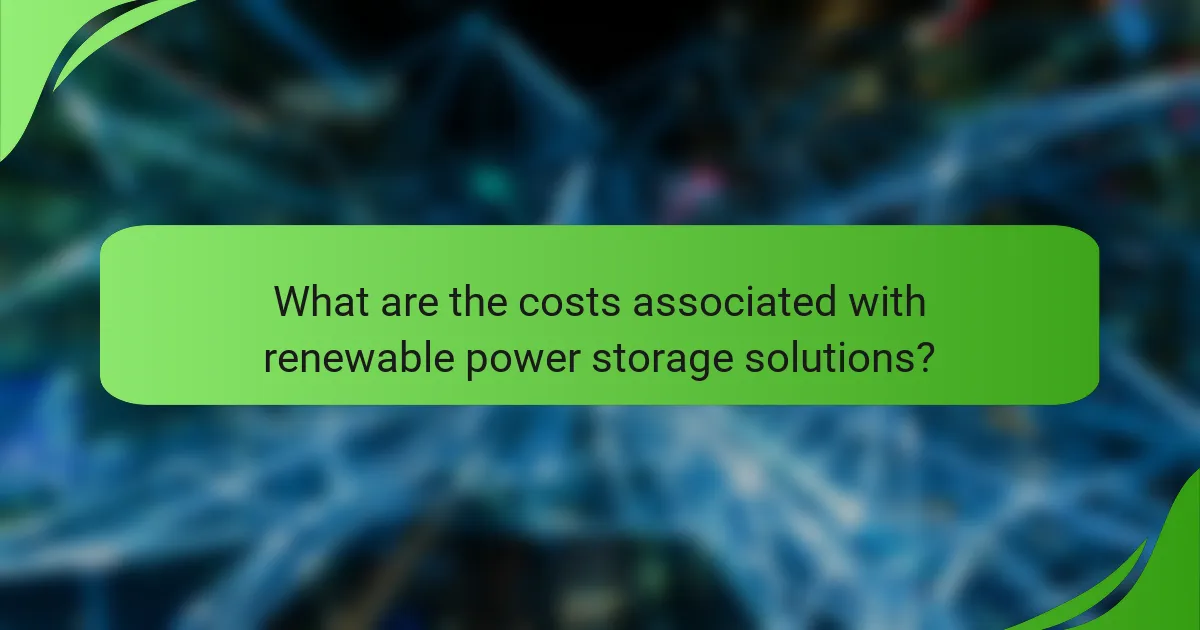
What are the costs associated with renewable power storage solutions?
The costs of renewable power storage solutions encompass various factors, including initial investment, installation, and ongoing maintenance. Understanding these costs is crucial for evaluating the overall feasibility and long-term savings of off-grid renewable energy systems.
Initial investment
The initial investment for renewable power storage solutions typically includes the purchase of batteries, inverters, and other necessary equipment. Depending on the technology, such as lithium-ion or lead-acid batteries, costs can range from a few thousand to tens of thousands of dollars.
When considering initial investments, it’s essential to factor in the capacity and expected lifespan of the storage system. Higher capacity systems may have a higher upfront cost but can provide better long-term value through increased efficiency and longevity.
Installation costs
Installation costs for renewable power storage systems can vary significantly based on the complexity of the setup and local labor rates. Generally, installation can add anywhere from 10% to 30% to the total project cost, depending on the system’s size and the specific requirements of the installation site.
It’s advisable to obtain multiple quotes from certified installers to ensure competitive pricing. Additionally, check for any local incentives or rebates that may help offset installation expenses.
Maintenance expenses
Maintenance expenses for renewable power storage solutions are typically lower than those for traditional energy systems, but they still require attention. Regular maintenance may include monitoring battery health, checking connections, and ensuring proper ventilation, which can cost a few hundred dollars annually.
To minimize maintenance costs, choose high-quality components and follow manufacturer guidelines. Being proactive about maintenance can extend the lifespan of the system and improve overall reliability.
